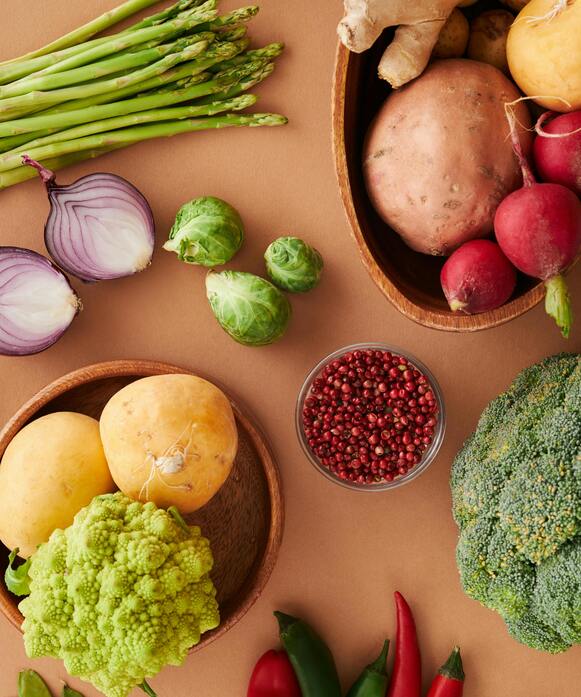High Fibre Foods You Should Eat
Date:
11 Jan 2022

We have all been told that a fibre-rich diet with a variety of whole foods is good for us. But do you know precisely why a high fibre diet is great for health and just how you can increase your daily intake to reap the benefits?
The British Nutrition Foundation states that we should aim for an intake of 30g per day for adults, with statistics showing the current average daily intake of fibre for men is 20.1g and 17.2g for women.1
Fibre can be described as ‘roughage’ produced from plant foods, which aren’t broken down by human enzymes as they pass through our digestive tract.2
Why is Fibre Good for You?
It is commonly known that fibre helps relieve constipation and bulk out stools, however, fibre also has quite an extensive and impressive range of health benefits:
- Increases satiety and the feeling of ‘fullness’ after a meal
- Helps to regulate blood sugar and support weight management3
- Maintains colon health4
- Reduces menopausal and PMS symptoms5
- Lowers cholesterol6
- Reduces the risk of Inflammatory Bowel Disease7
Fibre has also been studied for its preventative effects on colorectal cancer8 and a meta-analysis study shows that an increase of 10g of fibre a day reduced the risk for breast cancer by 4%.9
What’s the Difference Between Soluble and Insoluble Fibre?
Fibre can be classed into two categories: soluble (dissolves in water) or insoluble (doesn’t dissolve in water).
Many foods contain both soluble and insoluble fibre. It is important to get a mix of both types of fibre into your diet to gain the health benefits listed above.
Soluble Fibre
Soluble fibre can be described as viscous, meaning it forms a gel-like consistency when in water. This helps to regulate how quickly food is digested, increases nutrient absorption, and helps to stabilise blood sugar.10
It prolongs gastric emptying which increases the feeling of ‘fullness’ and satisfaction post-meal and can be a great tool to help manage hunger.11
Soluble fibre has even been shown to regulate insulin sensitivity and weight loss in diabetic individuals12 as well as lowering cholesterol levels.13
Insoluble Fibre
The main role of insoluble fibre is to help bulk out stools, reduce constipation by helping to pass solids more easily, and help to reduce bloating and excess gas.14
However, it is important to note that FODMAPS, which are fermentable oligo-, di-, monosaccharides, and polyols are insoluble fibres that draw water to the colon, and in IBS prone individuals, can cause abdominal distention and bacterial fermentation.15
Why Can Soluble Fibre be Described as Prebiotic?
Prebiotics are essentially food for the micro-organisms living in our gut and have a significant role in populating and impacting the ecology or ‘landscape’ of our microbiota.16
As mentioned, fibre cannot be broken down by human enzymes as it passes through the digestive tract.
Soluble fibre is therefore thought of as prebiotic because it reaches the intestines intact, as food for our gut bacteria to create short-chain fatty acids (SCFAs), which produce many hormones and enzymes used throughout the body and help boost digestive health.17
Inulin, a water-soluble food belonging to the carbohydrate group called fructans, is a particularly plentiful prebiotic source, in which chicory root contains some of the richest sources.18
Fibre-Rich Food Sources
For a list of soluble and insoluble fibre-rich food sources, see the table below. Please note that most sources naturally contain amounts of both types of fibre:
|
Food |
Serving Size (uncooked) |
Total Fibre (g) |
|
|
Insoluble Fibre Foods Bulks stool, |
Chestnuts |
1 cup |
16.7 |
|
Pine Nuts |
1 cup |
14.6 |
|
|
Cauliflower |
62g (1/2 a cup) |
1.4 |
|
|
Potatoes |
1 medium baked |
5 |
|
|
Turnips |
86g (1/2 a cup) |
2.7 |
|
|
Passionfruit |
110g (1/2 a cup) |
12.5 |
|
|
Flaxseeds |
2 tbsp |
6 |
|
|
Soluble Fibre Foods Slows digestion, |
Psyllium Husks |
2 tbsp |
7 |
|
Carrots |
1 medium |
2 |
|
|
Barley |
1 cup |
6 |
|
|
Lentils |
50g |
15 |
|
|
Pinto Beans |
50g |
7.5 |
|
|
Peas |
½ cup |
4.4 |
|
|
Oats |
1 cup |
8.2 |
How to Get More Fibre in Your Diet
The key is to focus on filling your plate with a variety of naturally processed whole grains, fruits, and vegetables. These foods contain a range of soluble and insoluble fibres to help increase intake.
Including a daily source of beans and lentils, which are notably high in dietary fibre, will also help you to meet the bulk of your daily requirement.
Another tip to boost daily intake is to add a handful of nuts and seeds to cereal and porridge in the morning along with sprinkling salads with flaxseeds and psyllium husks.
Always choose the wholegrain version when consuming carbohydrate sources such as pasta, rice, and noodles for a fibre-rich alternative.
Related content: How Much Fibre Do We Need To Eat Per Day?
References
1. Dietary fibre - British Nutrition Foundation
2. Fiber | The Nutrition Source | Harvard T.H. Chan School of Public Health
3. Dietary fiber and blood pressure control - PubMed (nih.gov)
4. Diet, microorganisms and their metabolites, and colon cancer - PubMed (nih.gov)
5. Dietary Flaxseed as a Strategy for Improving Human Health - PubMed (nih.gov)
6. β-glucans and cholesterol (Review) - PubMed (nih.gov)
7. Potential Benefits of Dietary Fibre Intervention in Inflammatory Bowel Disease - PubMed (nih.gov)
11. Top 25 Insoluble Fiber Foods and Comparison to Soluble Fiber - Dr. Axe (draxe.com)
12. Health benefits of dietary fiber - PubMed (nih.gov)
13. Dietary Fiber, Atherosclerosis, and Cardiovascular Disease - PubMed (nih.gov)
14. Insoluble Fibre and Diabetes - Sources, Health Benefits & Blood Glucose
15. Diet in irritable bowel syndrome - PubMed (nih.gov)
16. Dietary fiber and prebiotics and the gastrointestinal microbiota - PubMed (nih.gov)
17. Regulation of short-chain fatty acid production - PubMed (nih.gov)
18. Inulin: Properties, health benefits and food applications - PubMed (nih.gov)
















